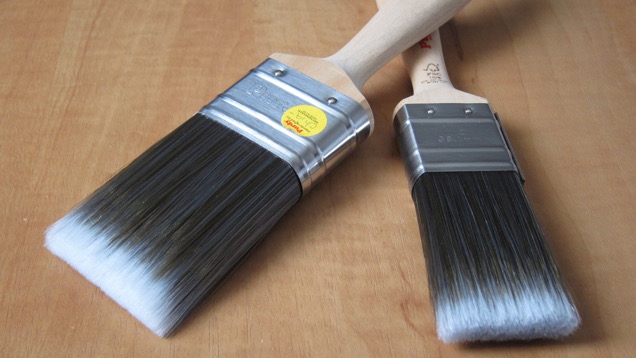Painting your interior walls is an easy, popular way to customise your space. Anyone can do it, but results may vary based on the type of brush you use. Here are some things to keep in mind when choosing the right paint brush for your next DIY painting project.
Picture: Keith Williamson
Good paint brushes, when properly cared for, can be used over and over again. First of all, skip the cheap brushes if you want to get multiple uses and high-quality results. You know the ones: they’re in the bargain bin or sold super-cheap in packs of 3. It may be tempting to save money on a cheap brush, but a good high-quality brush is almost as important as quality paint. A good brush will hold more paint and apply it evenly.
Next, the biggest factor in determining the right paint brush for your job is how you plan to use it. Are you painting large cabinet faces (where an 8cm brush with long bristles would make sense), or are you cutting in around a windowsill (where a 4cm angled brush would work best)? There’s always a tradeoff between precision and coverage and it’s better to invest in multiple brushes to do the job they were designed for.
Bristle Types
Natural-bristle paint brushes are best used for oil-based paints, varnishes, polyurethane and shellac. Never use natural-bristle brushes with water-based paint. They will soak up the water and leave your brush limp and unable to hold paint.
Polyester bristle paint brushes are used for latex paint and will hold their shape and stiffness well.
Polyester/nylon paint brush blends are ideal for latex paints and the combined bristles provide durability and shape to your brush.
Brush Widths
The majority of your paint jobs will require a brush from 2.5cm-10cm in width. The smaller 2.5cm-5cm brushes are best for window trim and detailed jobs. Medium sized 8cm brushes are useful for doors and cabinets, and large 10cm brushes work best for any large, wide area, like sections of wall or plywood.
Brush Styles
The “style” of your brush refers to the cut and shape of the brush head itself. As with other brushes, which one is right here depends on the type of job you’re doing.
A trim brush is a flat brush made for painting large flat surfaces.
A wall brush is a thicker flat brush that will hold a lot of paint and is used for painting large surfaces.
An angled sash brush has bristles that are cut at an angle and used for painting trim and around windows. A thin angled sash brush has a thinner profile and is ideal more delicate work. A flat sash brush retains a slim profile but the bristles are cut straight across.
Once you have your brushes, make sure to keep them properly cleaned, and they’re tools that can be used over and over again for multiple projects. Just keep these tips and definitions in mind before you go shopping, and you’ll make the best purchase for your next DIY painting project.

Comments